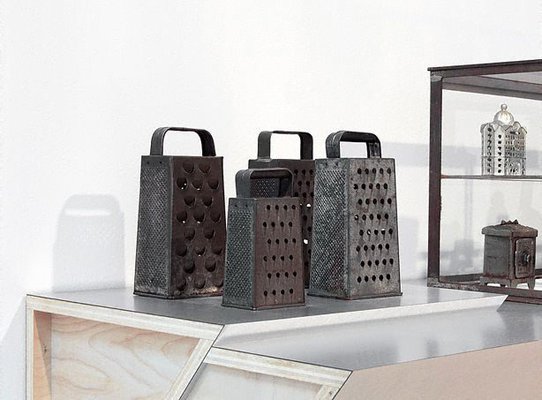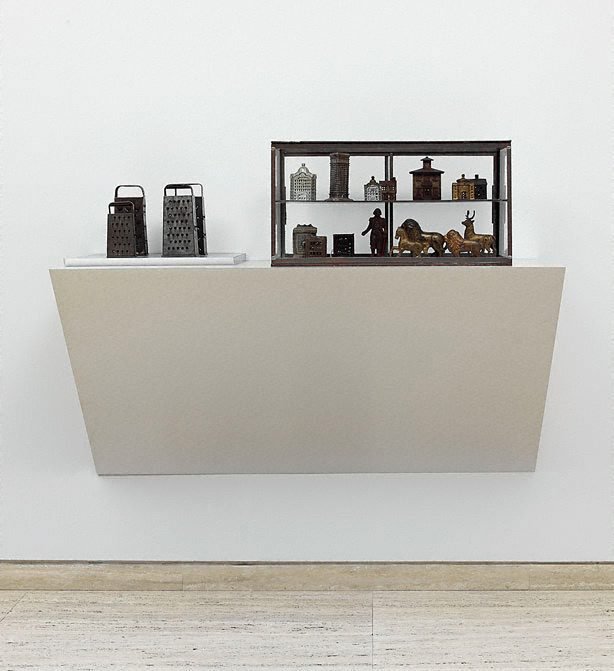Title
Untitled (graters, Victorian iron banks)
1990
Artist


-
Details
- Date
- 1990
- Media category
- Sculpture
- Materials used
- aluminium laminated wood shelf with glass display case and objects
- Dimensions
-
150.0 x 150.0 x 62.0 cm installed (from floor)
:
a - aluminium laminated wood shelf, 75 x 150 x 62 cm
b-d - 3 large graters (nos.2,3,4), 22.5 x 10.5 x 8 cm, each
e - small grater no.1, 17 x 9 x 6 cm
f - glass display case, 37 x 71 x 36.5 cm
g - B1 - large silver bank, 12 x 8 x 5 cm
h - F1 - triangular building, 15 x 9 x 11 cm
i - H1 - house with chimney on side, 8 x 6.5 x 5.5 cm
j - H2 - house with chimney centre, 8 x 6 x 6 cm
k - B2 - large bank with angled roof and centre tower, 14 x 11 x 9.5 cm
l - B3 - small silver bank, 8 x 5.3 x 4.4 cm
m - B4 - small bronze bank, 8 x 7 x 4.5 cm
n - S1 - small safe with round design on top and key, 8.5 x 6.5 x 5.5 cm, safe
n - S1 - small safe with round design on top and key, 3 x 1.3 cm, key
n - S1 - small safe with round design on top and key, 28 cm, string
o - S2 - large safe with "coin deposit bank" centre front, 12 x 7.5 x 7 cm
p - S3 - small safe, 8 x 6.5 x 5.5 cm
q - W1 - George Washington, 16.5 x 8 x 5 cm
r - A1 - horse, 11 x 13 x 3 cm
s - A2 - large lion, 13.5 x 12 x 6 cm
t - A3 - small lion, 10 x 13 x 4.5 cm
u - A4 - elk, 15.7 x 10 x 6.5 cm
- Signature & date
Not signed. Not dated.
- Credit
- Mervyn Horton Bequest Fund 1993
- Location
- Not on display
- Accession number
- 316.1993.a-u
- Copyright
- © Haim Steinbach
- Artist information
-
Haim Steinbach
Works in the collection
- Share
-
-
About
Haim Steinbach’s earliest works came out of minimalist painting and subsequently conceptual art but an early fascination with surrealism remains obvious in his work.1 He came to international prominence in the 1980s, when his use of found objects often caused him to be associated with the neo geo and commodity art movements that dominated New York at that time. In reality it makes more sense to think of his work in relation to European art and in particular to arte povera. This is because his works far exceed the literal presentation of readymades by engaging poetic associations and temporal structures that would be quite foreign to the materialist concerns of younger artists working in America.
In some ways Steinbach considers himself to be a kind of curator, investigating what the objects may have to say about their origins, their current location, their owners and maybe the curator. ‘Homage to Jan Hoet’, made for the exhibition Documenta IX in 1992, juxtaposed objects from the curator Jan Hoet’s home with a few objects borrowed from the museum where Hoet was the chief curator/ collector. In so doing he made a portrait of the curator as private individual and public figure.2
‘Untitled (graters, Victorian iron banks)’ presents and frames these found objects on a shelf designed for the purpose. The carefully crafted shelf contradicts the appropriative aspect of using found objects and suggests a highly specific sculptural format, implying two domains or contested hierarchies in representation. Steinbach retains enough of his training as a painter to view the surfaces of the laminates he applies to the shelf as important as the particular qualities of the objects. For example, the highly specific nature of each shelf makes it harder to ignore the shelf as a frame because it is chosen for its appropriateness to a dialogue with the found things upon it.
In Steinbach’s works, time is a continuing theme: he has juxtaposed the new and the antique, for example lava lamps suggestive of stoned meditation, with clocks and classical Greek figurines. Part of his interest in time relates to the idea of accumulation and erosion, time and change. In ‘Untitled (graters, Victorian iron banks)’ different rhythms are in play: cheese graters are used in a rapid up-and-down motion to reduce a block of cheese while the iron banks were made to slowly hoard cash and have now become hoarded objects, housed in a glass bank of their own.3
Steinbach is first and foremost a collector; his studio is full of found objects awaiting a chance encounter. He is very interested in the Duchampian or surrealist use of chance. For example, he regularly visits an antique shop in the small country town where he likes to spend his summer holidays. One day the woman who runs the shop took him out the back and showed him how she had anticipated his desires and accumulated a group of objects to make a work. Steinbach was delighted and accepted her choice as his own.
1. ‘I began working with already existing objects in the 1970s. The work came out of the investigations and reflections of conceptual art.’ Haim Steinbach in interview with Jen Budney, ‘Flash Art’, Nov/Dec 1996, pp 88-92
2. ‘I don’t make objects, I find them and present them. In doing so, I participate in an activity similar to archeologists and anthropologists.’ Steinbach 1996, pp 88–92
3. Trevor Smith, ‘Time signatures or Haim Steinbach’s still-life from Dubost’ in Jean Pierre et al, ‘Haim Steinbach’, Kunsthalle Ritter, Klagenfurt 1995© Art Gallery of New South Wales Contemporary Collection Handbook, 2006
-
Exhibition history
Shown in 2 exhibitions
The boundary rider: 9th Biennale of Sydney, Art Gallery of New South Wales, Sydney, 15 Dec 1992–14 Mar 1993
Reinventing the wheel: the readymade century, Monash University Museum of Art, Caulfield East, 03 Oct 2013–14 Dec 2013
-
Bibliography
Referenced in 7 publications
-
Art Gallery of New South Wales, Great gifts, great patrons: an exhibition celebrating private patronage of the Gallery, Sydney, 1994. no catalogue numbers
-
Anthony Bond and Victoria Lynn, AGNSW Collections, 'Contemporary Practice - Here, There, Everywhere ...', pg. 229-285, Sydney, 1994, 233 (colour illus.).
-
Anthony Bond, Contemporary: Art Gallery of New South Wales Contemporary Collection, 'Objects and associations', pg.332-381, Sydney, 2006, 376-7 (colour illus.). reproduction on pg.376 is a detail
-
Anthony Bond OAM and Yvonne Kennedy, The boundary rider: 9th Biennale of Sydney, Sydney, 1992, 222, 223 (colour illus.). no catalogue numbers
-
Charlotte Day, Reinventing the wheel: the readymade century, 'Introduction', pg.85-88, Melbourne, 2013, 48 (colour illus.), 86.
-
Trevor Smith (German and English versions) English version, Haim Steinbach, 'Time signatures or Haim Steinbach's still-life', pg. 20-27, Germany, 1994, 115 (illus.). This work is not in this exhibition but is illustrated in the catalogue.
-
Paula Latos-Valier, Biennale of Sydney 2000, 'Looking back: the biennale of Sydney 1973-1998', pg.160-190, Sydney, 2000, 184 (colour illus.). This work is not in this exhibition but is illustrated in the catalogue.
-
